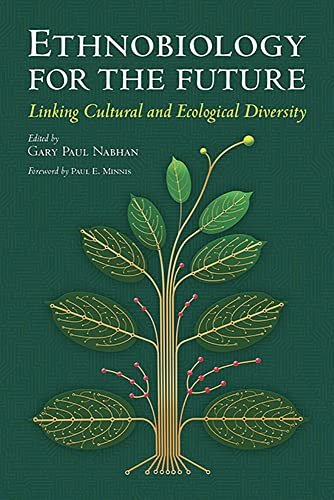Tuesday, 10 March 2020
Ethnobiology for the Future: Linking Cultural and Ecological Diversity by Gary Paul Nabhan
Ethnobiology for the Future: Linking Cultural and Ecological Diversity by Gary Paul Nabhan

No one has done more than Gary Nabhan to bring the central tenets of ethnobiology to a broad audience. That there is an inextricable link between biological and cultural diversity, that indigenous people often know far more about biological (and, especially, agricultural) diversity than do members of industrialized society, and that global well–being is tied to the well–being of biocultural diversity are constant and consistent themes that have clearly and consistently threaded through most of his writings for well over three decades.
Nabhan first came to the attention of the reading public with his first two lyrical books on the intertwined agricultural and biological diversity on the U.S.–Mexican border: The Desert Smells like Rain (Nabhan, 1982) and Gathering the Desert (Nabhan, 1985). These two volumes charted the path for the more than three dozen books that would follow: Gary in some out–of–the–way locale, conversing with some local folks and revealing layer upon layer of knowledge, mystery, and meaning—a process that continues to and through Ethnobiology for the Future. The subtitle of this new book is “Linking Cultural and Ecological Diversity,” but it could just as accurately have been entitled “A Nabhan Reader.” This volume is an intriguing collection of essays old and new, some written specifically for this volume, others that have been published as blogs or in both mainstream and more obscure places. Nabhan is the sole author of seven of the 20 pieces; the rest are coauthored with other ethnobiologists, ecologists, geographers, historians, food historians, and Native American colleagues (mind you, most of the authors fit in more than one of these categories). With Gary as a guide and teacher, the reader travels from Arizona to Oman; from the Sea of Cortez to the Indian Ocean—with many stops along the way. And extraordinary characters appear: Herodotus, Pliny the Elder, Java Man, E.O. Wilson, Alfred Russel Wallace, and Nikolai Vavilov, to name just a few. Nor is this book limited to plants: as appropriate for a volume devoted to ethnobiology, condors, hawkmoths, oysters, scallops, sea turtles, and other creatures feature prominently, always in the context of their role within the ecosystem and the local knowledge about their place in the web of life. In an age where indigenous cultures face rapid change, and when primary ecosystems face growing threats, one might wonder not only what is the future of ethnobiology but also whether there is a future for ethnobiology. Nabhan addresses this head on in a powerful opening essay entitled, “Letter to Young Ethnobiologists.” (spoiler: there is!) From there, Gary and his colleagues focus on three major issues: redefining ethnobiology, showing how and why ethnobiology is essential to biocultural conservation, and how to broaden the appeal and impact of ethnobiology. In short, this book will be devoured by all fellow Nabhanophiles and should be read by all those interested in food, culture, conservation, botany, and the worlds around them. So chock full of great ideas, penetrating insights and unforgettable landscapes is this book, however, that it should be savored slowly like the fine feast it is!